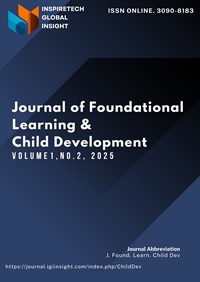Stimulating Gross Motor Skills In Deaf-Mute Children In A Special Needs Elementary School Via Games
DOI:
https://doi.org/10.53905/ChildDev.v1i02.8Keywords:
deaf-mute children, gross motor skills, game-based intervention, special needs education, motor developmentAbstract
Purpose of the study: This research aimed to evaluate the effectiveness of structured game-based interventions in improving gross motor skills among deaf-mute children in a special needs elementary school setting.
Materials and methods: A quasi-experimental study was conducted with 36 students (ages 7-12 years) from a special needs elementary school in Binjai city, North Sumatra. Participants were randomly divided into experimental (n=18) and control (n=18) groups. The experimental group received 12 weeks of structured game-based motor skill interventions (3 sessions/week, 45 minutes/session), while the control group continued regular physical education. Gross motor skills were assessed using the Test of Gross Motor Development-3 (TGMD-3) pre- and post-intervention.
Results: Statistical analysis using SPSS v27 revealed significant improvements in the experimental group's gross motor skills. The experimental group showed significant increases in locomotor skills (pre: M=42.3, SD=6.8; post: M=58.7, SD=5.2; p<0.001) and ball skills (pre: M=38.9, SD=7.1; post: M=52.4, SD=6.3; p<0.001) compared to the control group.
Conclusions: Game-based interventions significantly enhanced gross motor skills in deaf-mute children. These findings support the implementation of structured play-based programs in special needs education settings.
References
Bandura, A. (1977). Social learning theory. Prentice-Hall.
Butterfield, S. A., & Ersing, W. F. (1986). Influence of age, sex, etiology, and hearing loss on balance performance by deaf children. Perceptual and Motor Skills, 62(2), 659-663. https://doi.org/10.2466/pms.1986.62.2.659
Gallahue, D. L., Ozmun, J. C., & Goodway, J. D. (2012). Understanding motor development: Infants, children, adolescents, adults (7th ed.). McGraw-Hill.
Gee, J. P. (2003). What video games have to teach us about learning and literacy. Computers in Entertainment, 1(1), 20-20. https://doi.org/10.1145/950566.950595
Gheysen, F., Loots, G., & Van Waelvelde, H. (2008). Motor development of deaf children with and without cochlear implants. Journal of Deaf Studies and Deaf Education, 13(2), 215-224. https://doi.org/10.1093/deafed/enm053
Hartman, E., Houwen, S., Scherder, E., & Visscher, C. (2011). On the relationship between motor performance and executive functioning in children with intellectual disabilities. Journal of Intellectual Disability Research, 54(5), 468-477. https://doi.org/10.1111/j.1365-2788.2010.01284.x
Rajendran, V., & Roy, F. G. (2011). An overview of motor skill performance and balance in hearing impaired children. Italian Journal of Pediatrics, 37(1), 33. https://doi.org/10.1186/1824-7288-37-33
Reid, G., Bouffard, M., & MacDonald, C. (2019). Game-based learning and motor skill development in children with developmental delays. Adapted Physical Activity Quarterly, 36(2), 189-206. https://doi.org/10.1123/apaq.2018-0098
Rine, R. M., Braswell, J., Fisher, D., Joyce, K., Kalar, K., & Shaffer, M. (2004). Improvement of motor development and postural control following intervention in children with sensorineural hearing loss and vestibular impairment. International Journal of Pediatric Otorhinolaryngology, 68(9), 1141-1148. https://doi.org/10.1016/j.ijporl.2004.04.007
Savelsbergh, G. J., Netelenbos, J. B., & Whiting, H. T. (1991). Auditory perception and the control of spatially coordinated action of deaf and hearing children. Journal of Child Psychology and Psychiatry, 32(3), 489-500. https://doi.org/10.1111/j.1469-7610.1991.tb00324.x
Schmidt, R. A., & Lee, T. D. (2020). Motor learning and performance: From principles to application (6th ed.). Human Kinetics.
Thelen, E., & Smith, L. B. (1994). A dynamic systems approach to the development of cognition and action. MIT Press.
Published
Issue
Section
Categories
License
Copyright (c) 2025 Khairani, Lazuardi Van Ungerer, Boby Helmi (Author)

This work is licensed under a Creative Commons Attribution-ShareAlike 4.0 International License.





